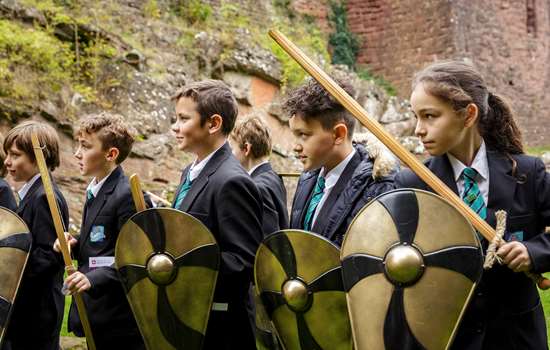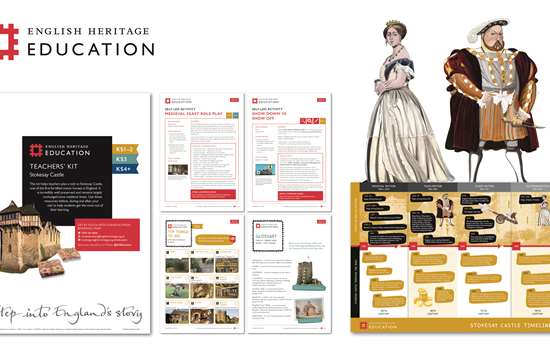Get to Grips with the Area
Although the age of the earthworks (a motte and bailey) of Warkworth Castle is uncertain, the oldest stone structures – the curtain wall, parts of some buildings in the bailey, the gatehouse and the Carrickfergus Tower – were probably built by c.1200. From the late 13th century, castles in the north of England began to play an increasingly important role in long-running conflicts between England and Scotland and in 1327 Warkworth Castle was besieged by the Scots.
We can learn a lot about the history of the area around Warkworth, and England's national story, by charting the story of the Percy family. Henry Percy, 2nd Lord Percy was granted Warkworth Castle in 1328 by Edward III. It was at this time that the Percy family was emerging as one of the most important in the north of England. Henry Percy (1341–1408), 1st Earl of Northumberland was the first great landowner in the north to be given a noble title and it's believed he celebrated this achievement by building the great tower at Warkworth. During the 1400s and 1500s the Percys both rose to prominence and fell from grace following their involvement in unsuccessful uprisings and conflicts like the Wars of the Roses. Periods of repair and construction were interrupted when members of the Percy family were arrested and imprisoned following their involvement in the unsuccessful Rising of the North (1569) and the Gunpowder Plot (1605).
By the 17th century, parts of the castle were ruinous and during the English Civil War, withdrawing Parliamentarian forces may have been responsible for reducing the bailey to the condition you can see today. The castle, together with the hermitage, became a tourist destination, especially after Bishop Percy published his poem, 'The Hermit of Warkworth' in 1771. Restoration in the 19th century provided rooms within the Great Tower for the Duke and Duchess of Northumberland to use with their guests during picnics in the summer. In 1915, the castle was declared a scheduled monument and it was taken into state guardianship in 1922, largely breaking Warkworth's centuries-old link with the Percy family.
Top Resources
-
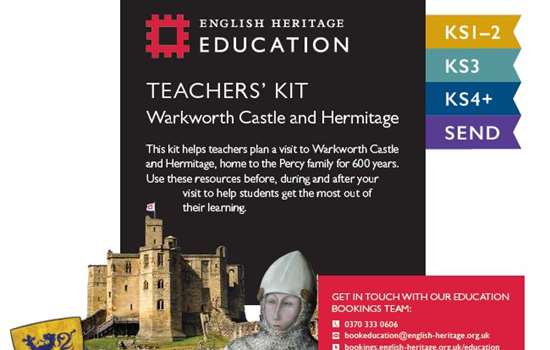
Warkworth Castle and Hermitage Teachers' Kit (KS1-KS4)
Our Teachers’ Kits feature historical information and activity suggestions for group leaders of various subjects and key stages.
-
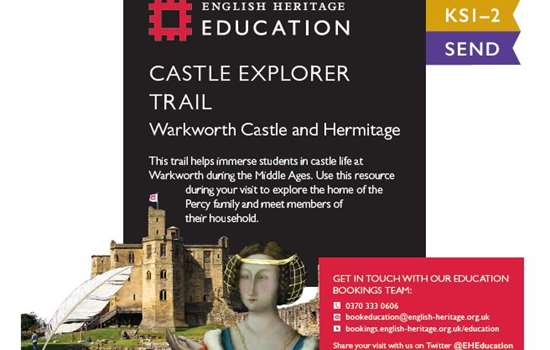
Castle Explorers Trail (KS1-KS2)
Book our Castle Explorer Trail and use character cards, objects and smell boxes to immerse students in medieval life at Warkworth Castle during your visit.
-
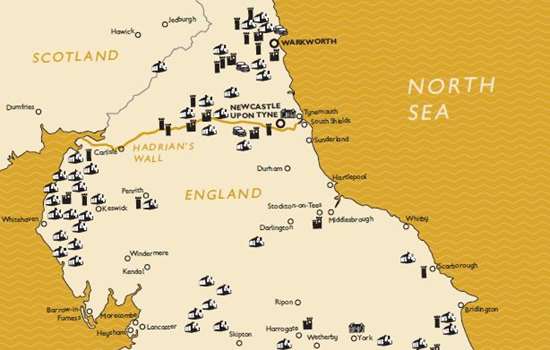
Percy Estates Map
Use our map of the Percy estates in Cumbria, Northumberland and Yorkshire to explore the types of property owned by the Earl of Northumberland in the 15th century.
-

Our Guide to Heraldry
Understand heraldic design by using our guide to develop your own coat of arms.
Suggested Activities
-

Why Build a Power Base Here? (KS2-KS3) - Warkworth Castle Teachers' Kit
Consider why the Percy family came to prominence in the north of England and compare modern and historic maps to explore the nature of medieval lordship in towns like Warkworth.
-

Power on the Tower (KS2-KS3) - Warkworth Castle Teachers' Activity Ideas
Understand the history and importance of heraldry and mottos to medieval families by investigating heraldic features at Warkworth Castle.
-

Town and Castle Inspiration Walk (KS2-KS3) - Warkworth Castle Teachers' Kit
Explore Warkworth Castle and the medieval features in the town surrounding it to gather inspiraition for your own creative writing and visual art, just like artists and writers have throughout history.
-

Sculpture Seekers (KS2-KS3) - Warkworth Castle Teachers' Kit
Follow in the footsteps of real people from Warkworth's past to discover more about key events in the castle's story. Can you find the sculpture at the end of each character's trail?
Video Resources
-
A Mini Guide to Medieval Castles
Discover the changing design and uses of medieval castles in this short animation.
-
History at Home Live! Castles
Join Ben Shires and our expert Jeremy Ashbee to discover more about castles throughout history.
-
How to Take a Medieval Castle
Find out about the different ways to take a medieval castle.
-
Postcard from Warkworth Castle and Hermitage
Uncover the location and landscape at Warkworth Castle and Hermitage in our birds-eye view video.
Link Your Learning
ENGLISH - Read extracts from the poem 'Hermit of Warkworth' (1771) by Bishop Percy and ask your learners to use the text as inspiration for their own story or poem about Warkworth's legendary hermit.
SCIENCE - Walk along a stretch of the river Coquet that runs through Warkworth and record the wildlife and plants you spot on your way. Learners could compare their findings as you go or as part of class discussion back at school. If you're unsure of a species, jot down a description or take a picture to use in further research back in the classroom.
MATHS - Use medieval shields and the coats of arms displayed on them to help your learners understand fractions. Find out more about heraldic design in our learning activity and encourage your learners to create their own. They could work with design constraints involving fractions to build their understanding (e.g. only use animals on 1/4 of your shield and red on 4/8).
GEOGRAPHY - Use a map of Warkworth and satellite view to explore the medieval infrastructure that can still be seen in the townscape today. This includes the castle and the long gardens behind houses in the town centre. Consider which features were familiar to people in the Middle Ages and which features of the townscape and landscape are more recent.
ART AND DESIGN - The Percy family presented their wealth and power through their residences, like Warkworth Castle, which towered over the local landscape. Ask your learners to create their own design for a new castle tower incorporating their own heraldic designs. They could use this initial design to create a 3D model from recycled materials.
DRAMA - How do your learners think the Percy family behaved as powerful local landowners in the Middle Ages? Challenge them to carry themselves as lords and ladies and act like medieval nobility. You could re-enact a medieval banquet like those that took place at Warkworth Castle.
Visiting Warkworth Castle and Hermitage
Find Out More'Linking your teaching to your local area is a fantastic way for your students to learn more about their locality, and understand why and how their community has changed and developed. By booking a free education visit to one of our sites, you can explore local stories and bring the history of the area to life.
Warkworth Castle’s prominent position overlooking the village of Warkworth remains unchanged since medieval times. You can still identify many of its defensive features as well as how the castle served as a home to the Percy family. The castle, hermitage and surrounding area provide the perfect landscape for an enriching, cross-curricular approach to your topic, including history, geography, art and English and students have the opportunity to develop their enquiry skills in a variety of different ways.
Education visits to Warkworth Castle are free, as is a planning visit for the group leaders, which provides the chance to explore the castle and the local area to ensure that you can make the most of your trip. To support your planning, there is a wide range of downloadable resources available, with information to support students’ learning before, during and after their trip. If there is any way I can help with your visit to Warkworth Castle, please do not hesitate to contact me!'
- Helen Klemm, Education Visits Officer (North East)

